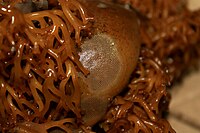bio.wikisort.org - Plant
Macrocystis integrifolia was considered a distinct species of giant kelp in the genus Macrocystis , based on blade and holdfast morphology. As of 2009, phycologists have collapsed Macrocystis integrifolia and the various other giant kelps into the single species, Macrocystis pyrifera.[3]
It has been suggested that this article be merged into Macrocystis. (Discuss) Proposed since May 2022. |
| Macrocystis integrifolia | |
|---|---|
 | |
| Macrocystis integrifolia | |
| Scientific classification | |
| (unranked): | SAR |
| Superphylum: | Heterokonta |
| Class: | Phaeophyceae |
| Order: | Laminariales |
| Family: | Laminariaceae |
| Genus: | |
| Species: | M. pyrifera |
| Binomial name | |
| Macrocystis integrifolia Bory de Saint-Vincent 1826[1] | |
| Synonyms | |
|
Macrocystis pyrifera (Linnaeus) C. Agardh[2] | |
Description
Deep brown color on flattened rhizomes which are profusely dichotomously branched. Each is attached by branched root-like structures coming out of the sides of the rhizomes. Slender main stipes (about 1 centimetre (0.39 in) wide to 30 metres (98 ft) long) come from the rhizome which is up to 0.1 metres (3.9 in) at the widest. Periodically 5 centimetres (2.0 in) wide and 35 centimetres (14 in) long flattened leaf-like branches derive from the stipe. They have furrowed surfaces and taper gradually, but then have an oval or rounded float where attached to the stipe. The blade-like branches have notched denticulate edges leading to the terminal blade at the tip of the stipe, which is separated by several smaller branches.[4]
Life history
It is found on intertidal rocks or shallow subtidal rocks along the Pacific coast of North America from British Columbia to California.[2][5][6] It prefers water about 7 metres (23 ft) to 10 metres (33 ft) deep and exposed to the open sea and normal salinities, yet sheltered from full wave action.[7]
Macrocystis integrifolia alternates heteromorphic phases from a macroscopic sporophyte to dioecious microscopic gametophytes.[6] It has been studied as a plant fertilizer, increasing bean yields up to 24% and chemical studies indicate presence of phytohormone-like substances.[8]
In 2009, a study concluded that Macrocystis pyrifera is monospecific.[9]
References
- Bory de Saint-Vincent, J.B.G.M. (1826). Macrocyste. In: Dictionnaire Classique d'Histoire Naturelle. (Audouin, I. et al. Eds) Vol. 10, pp. 8-10. Paris:
- Guiry, M.D. & Guiry, G.M., AlgaeBase: Species: Macrocystis integrifolia, National University of Ireland, Galway. Retrieved 7 February 2013.
- Demes, Kyle W.; Graham, Michael H.; Suskiewicz, Thew S. (December 2009). "PHENOTYPIC PLASTICITY RECONCILES INCONGRUOUS MOLECULAR AND MORPHOLOGICAL TAXONOMIES: THE GIANT KELP, MACROCYSTIS (LAMINARIALES, PHAEOPHYCEAE), IS A MONOSPECIFIC GENUS1: MACROCYSTIS IS A MONOSPECIFIC GENUS". Journal of Phycology. 45 (6): 1266–1269. doi:10.1111/j.1529-8817.2009.00752.x.
- Phylum: Phaeophyta, Class: Phaeophyceae, Order: Laminariales, Family: Lessoniaceae, Macrocystis integrifolia (Bory), Pearson College UWC. Retrieved 6 February 2013
- Abbott, I. A. & G. J. Hollenberg. (1976) Marine Algae of California. California: Stanford University Press. ISBN 0-8047-0867-3
- Macrocystis integrifolia Bory, DeCew's Guide to the Seaweeds of British Columbia, Washington, Oregon, and Northern California, Center for Phycological Documentation, University Herbarium, University of California, Berkeley, 2002. 13 July 2007
- The Race Rocks Taxonomy, Macrocystis integrifolia, Pearson College UWC. Retrieved 6 February 2013
- Temple, W. D., A. A. Bomke, Effects of kelp (Macrocystis integrifolia and Ecklonia maxima) foliar applications on bean crop growth, Plant and Soil, June 1989, Volume 117, Issue 1, pp. 85-92 (paywall)
- Demes, K.W, Graham, M.H. & Suskiewicz, T.S. (2009). Phenotypic plasticity reconciles incongruous molecular and morphological taxonomies: the giant kelp, Macrocystis (Laminariales, Phaeophyceae), is a monospecific genus (note). Journal of Phycology 45(6): 1266-1269.
External links
- Macrocystis integrifolia Bory California Biota Home Page... Protoctista... Phaeophyta
Другой контент может иметь иную лицензию. Перед использованием материалов сайта WikiSort.org внимательно изучите правила лицензирования конкретных элементов наполнения сайта.
WikiSort.org - проект по пересортировке и дополнению контента Википедии